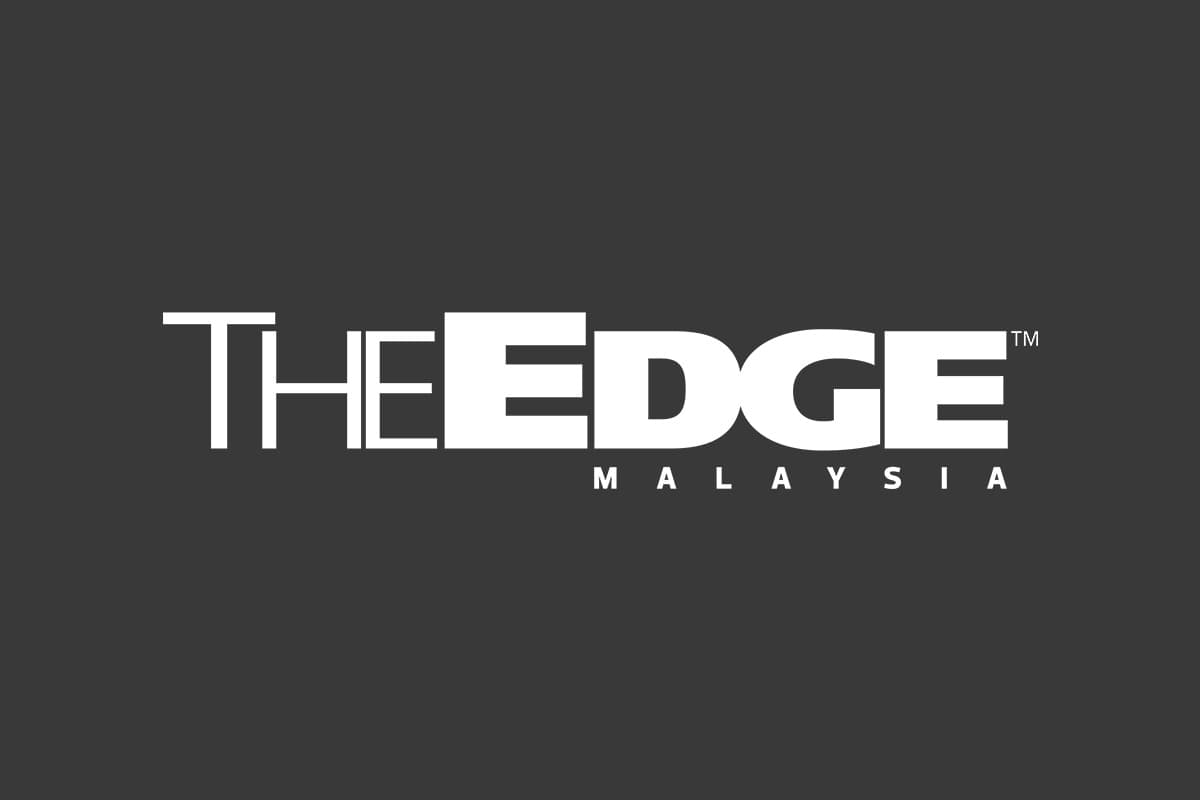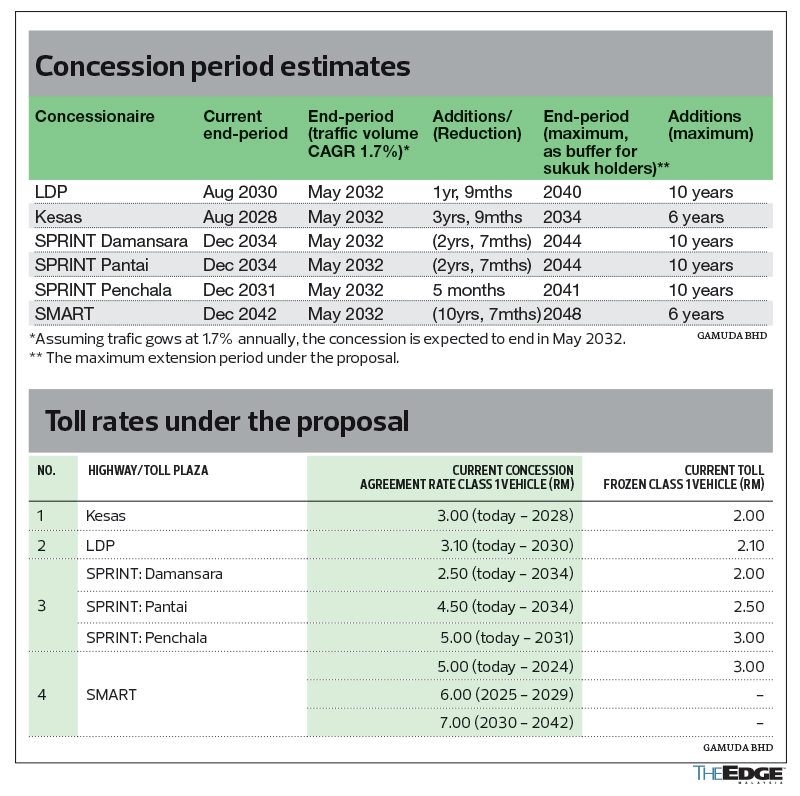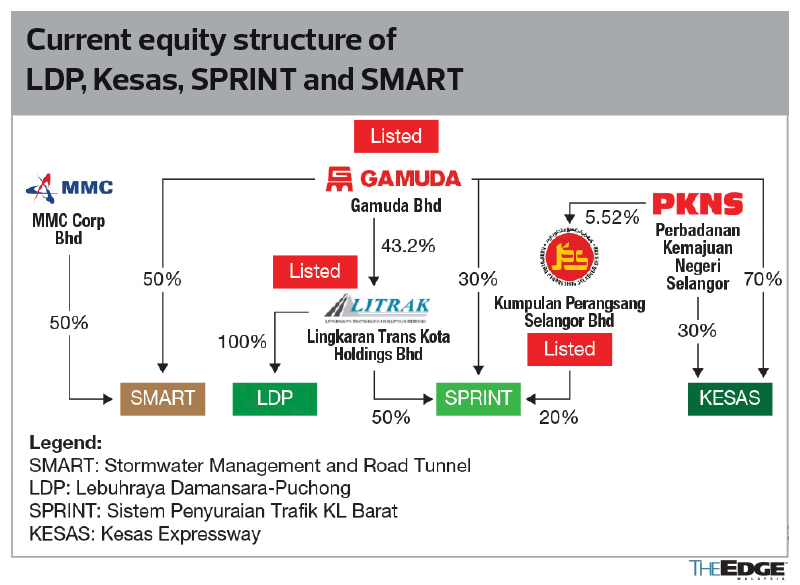
This article first appeared in The Edge Malaysia Weekly on April 11, 2022 - April 17, 2022
IT was not a secret that a corporate exercise involving highways under Gamuda Bhd was in the offing. Nevertheless, the timing and the structure of the corporate exercise that was put in place caught the market by surprise.
Until early last Monday, nobody knew of the existence of an entity known as Amanat Lebuhraya Rakyat Bhd (ALR). But by late afternoon, ALR was hogging the limelight. Prime Minister Datuk Seri Ismail Sabri Yaakob and Works Minister Datuk Seri Fadillah Yusof announced that the company would take over the four highways under Gamuda and its associate company Lingkaran Trans Kota Holdings Bhd (Litrak).
The four concession companies and their respective highways to be taken over by ALR are Kesas Sdn Bhd (Kesas Expressway), Syarikat Mengurus Air Banjir dan Terowong Sdn Bhd (SMART Tunnel), Sistem Penyuraian Trafik KL Barat Sdn Bhd (SPRINT Expressway) and Lingkaran Trans Kota Sdn Bhd (Damansara-Puchong Expressway, or LDP).
Kesas is 70%-owned by Gamuda, while the remaining 30% is held by Perbadanan Kemajuan Negeri Selangor (PKNS). SMART is a 50:50 joint venture between MMC Corp Bhd and Gamuda.
As for SPRINT, Litrak holds 50% equity interest in the highway concessionaire, while Gamuda and Kumpulan Perangsang Selangor Bhd (KPS) hold 30% and 20% respectively. LDP is wholly-owned by Litrak, which in turn is 43.17% controlled by Gamuda. Hence, Gamuda’s effective interest in SPRINT is 51.6%.
To recap, under the government’s proposal, Gamuda and Litrak received offers from ALR to buy up the entire equity interest in the highway concessionaires in a deal that would eventually see the toll charges for the use of the highways being abolished. ALR values the four highways at RM5.4 billion, including debts of RM2.06 billion.
ALR plans to raise funds through the issuance of a sukuk and repay sukuk holders using the net proceeds from the toll collection. After the sukuk has been repaid, the company will hand over the highways to the government.
An integral feature of the proposal is the extension of the concession period of the highways of between six and 10 years. In return, the toll rates remain unchanged and collection will cease when the proceeds are sufficient to redeem the sukuk. The target date for this is May 2032.
Since the proposal was announced by the prime minister and works minister themselves, the government’s green light is a given.
As for shareholders of Gamuda and Litrak, it is unlikely that they will oppose the proposal because it allows them to exit an investment that has been on their books for more than 20 years. Also, the surplus cash flow will come in handy when bidding for new infrastructure jobs.
The proceeds from the sale of the highways will turn Gamuda into a net cash company of RM600 million, compared with net debts of RM1.7 billion now. KPS is likely to get RM181 million, while the transaction values Litrak at RM2.698 billion, or an indicative price of RM5.08 per share.
Take-up of bonds
A corporate exercise involving highways under Gamuda has been on the cards for more than seven years. It gained traction in 2019, when Pakatan Harapan (PH) was in control of Putrajaya, with the transaction valued at RM6.2 billion at the time.
Gamuda deputy group managing director Mohammed Rashdan Mohd Yusof still remembers the day when the deal was scuttled. “We were supposed to sign the SPA (sale and purchase agreement) with the government in February 2020, but that was when Tun Dr Mahathir Mohamad resigned as prime minister,” he tells The Edge in an interview.
The journey has been long and arduous for Rashdan, who has been working on monetising the highways for more than four years. After the PH deal was put on the back burner, he continued to work on another proposal.
A highway trust was then proposed, where the highways would be injected into a trust that would issue bonds that come with a partial government guarantee (GG). Meanwhile, the bonds would be repaid through the proceeds from the toll collection, with the GG being an added assurance. However, this proposal did not get the approval of the government as it did not want to increase its liabilities.
Early last year, ALR approached Gamuda with the current proposal. The discussions eventually culminated in the announcement by the prime minister last Monday.
Rashdan feels that nobody loses out under the current proposal. He explains that although the extension of the concession period is between six and 10 years, the sukuk is expected to be fully redeemed by 2032, based on a base case traffic volume compound annual growth rate (CAGR) of 1.7% per annum.
“The redemption date is based on the assumption that traffic grows at 1.7% and toll rates remain. If traffic growth is higher than 1.7%, the sukuk should be able to be redeemed earlier,” he says.
Rashdan thinks ALR will issue the sukuk in a series of tranches up to 15 years and it should qualify for a good rating, maybe even AAA.
Although the sukuk is expected to get a high rating, investors will still want some kind of assurance that the paper will be redeemed in the event there is a situation that is beyond anyone’s control that causes a reduction in traffic.
“The problem with long-term paper is that the cash flow cannot be predicted with certainty. For instance, if there is another lockdown, it will affect traffic flow and toll collection. Bond investors would want some kind of protection against such downside,” says an analyst who follows the bond ratings of highways.
The analyst points out that Maju Expressway Sdn Bhd’s MEX Highway bonds were downgraded due to the drop in traffic during the pandemic.
See also “Slippery road to toll-free highways’ on Page 39
Save by subscribing to us for your print and/or digital copy.
P/S: The Edge is also available on Apple's App Store and Android's Google Play.
- Fire incident in Putra Heights not related to Gas Malaysia facilities, company says
- Petronas confirms fire incident at Petronas Gas main pipeline near Puchong
- Massive gas pipeline fire in Puchong — Fire Dept
- Gas pipeline blaze: 25 receiving initial medical treatment as of 10.35am
- Singapore’s Capital World says MACC froze its unit CCP’s bank accounts to facilitate ongoing investigations
- Sumbangan Asas Rahmah credited on April 1, recipients describe it as Syawal windfall
- Gas pipeline blaze: 190 houses, 159 vehicles damaged
- SoftBank seeks record US$16.5b loan for AI growth in US — Bloomberg
- RHB Singapore appoints Goh Ken-Yi as CEO
- Gas pipeline blaze: Immediate financial aid for over 100 affected residents, says PM



